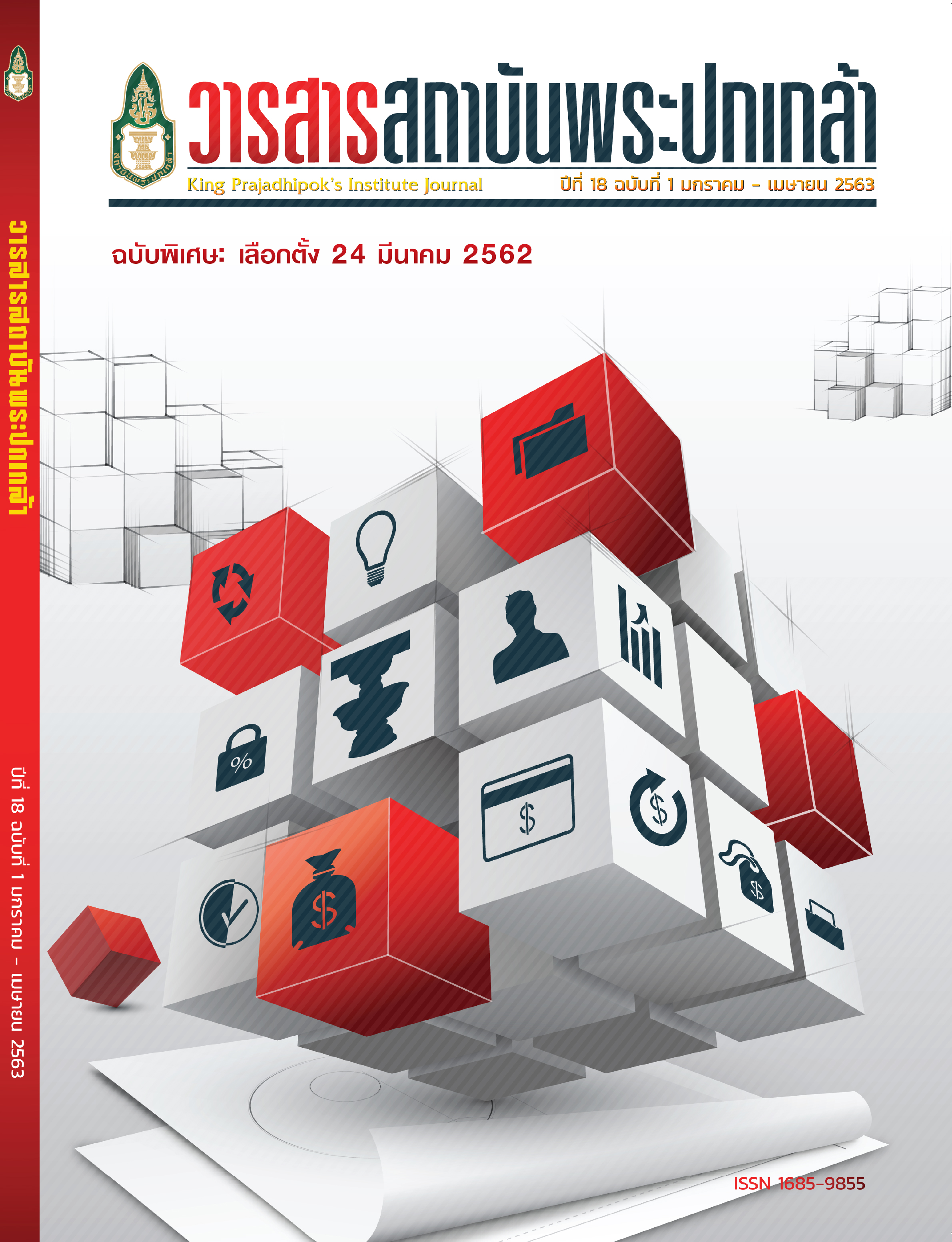Political Communication in Phayao’s General Election 2019 under Thailand’s 2017 Constitution
Main Article Content
Abstract
This article aims to discuss 2019 general election situation and political communication between the electoral candidates/their teams of canvassers vis-a-vis the electorate under the 2017 Constitution and its prescribed mixed member apportionment (MMA) system. The research employed quantitative and qualitative methodology. It covered the period from the announcement of the Election Royal Decree 2019 (January 23, 2019) till the Election Day (March 24, 2019).
The findings are as follow. 1) Regarding the situation of the general election in Phayao,the political momentum swung to new political parties such as Palang Pracharat Party (PPRP) and Future Forward Party (FFP). There were 85 candidates, which was the highest number of any Thai election. This is possibly due to the MMA system that is designed to include the number of votes on the party list in the calculation of number of MPs. 2) Political communication was multi-directional by means of open and confidential messages. Regarding the candidates, they analyzed and designed messages and media to reach voters according to age groups and occupations. As for the voters, their ways to receive and send messages varied greatly among different age groups. It is evident that those within the range of 18-22 and of 23-36 were receptive to the campaign strategy of the choice of prime minister. Those within the age groups of 36-59 and over 60, however, were of a different inclination. The latter gave more weight the traits of individual candidates. The main reason could be attributed to their past experiences, namely, to have MP of their own choice would answer to their local needs better than the propagators of national party policies. Furthermore, this also conveniently benefited big parties with ample financial resources, as they could better afford the local candidates’ political communication campaigns. Moreover, the delay in the official campaign period led to the rally on individual candidates all the same and not on party policies yet to be approved by the EC. Consequently, this practice was conducive to vote-buying ingrained in the patronage system.
Article Details
@ 2020 King Prajadhipok's Institute The Government Complex Commemorating All Right Reserved.
References
กระทรวงสาธารณสุข. (2562). ตัวชี้วัดของกระทรวงสาธารณสุข ปีงบประมาณ 2562 จังหวัดพะเยา. สืบค้นจาก http://203.209.96.245/sapa/frontend/web/index.php
คณะกรรมการการเลือกตั้ง. (2561). ประกาศคณะกรรมการการเลือกตั้ง เรื่อง จำนวนสมาชิกสภาผู้แทนราษฎรแบบแบ่งเขตเลือกตั้งที่แต่ละจังหวัดจะพึงมีและจำนวนเขตเลือกตั้งแบบแบ่งเขตเลือกตั้งของแต่ละจังหวัด. ลงวันที่ 19 กันยายน 2561.
คณะกรรมการการเลือกตั้งประจำจังหวัดพะเยา. (2561, 2 ตุลาคม). ประกาศคณะกรรมการการเลือกตั้งจังหวัดพะเยา เรื่อง รูปแบบการแบ่งเขตเลือกตั้งของจังหวัดพะเยา เพื่อรับฟังความคิดเห็นของพรรคการเมืองและจังหวัดประชาชนในจังหวัดพะเยา.
คณะกรรมการการเลือกตั้งประจำจังหวัดพะเยา. (2562). ข้อมูลการลงคะแนนใช้สิทธิเลือกตั้งสมาชิกสภาผู้แทนราษฎร จังหวัดพะเยา. พะเยา: คณะกรรมการการเลือกตั้งประจำจังหวัดพะเยา.
ณสดมภ์ ธิติปรีชา. (2554). ระบบการเลือกตั้งและการจัดการเลือกตั้ง: เป้าหมายและผลลัพธ์ทางการเมือง. กรุงเทพฯ: จุฬาลงกรณ์มหาวิทยาลัย.
ผู้มีสิทธ์เลือกตั้งเขต 2 จังหวัดพะเยา, (24 มีนาคม 2562). สัมภาษณ์.
ผู้อำนวยการการเลือกตั้งจังหวัดพะเยา, (1 มีนาคม 2562). สัมภาษณ์.
ยุทธพร อิสรชัย. (2561). แนวคิดการสื่อสารทางการเมือง, ใน ประมวลสาระชุดวิชาการวิเคราะห์การเมือง. นนทบุรี: สำนักพิมพ์มหาวิทยาลัยสุโขทัยธรรมาธิราช.
สภานิติบัญญัติแห่งชาติ. (2561, 28 กุมภาพันธ์). รายงานพิจารณาร่างพระราชบัญญัติประกอบรัฐธรรมนูญว่าด้วยการเลือกตั้งสมาชิกสภาผู้แทนราษฎร พ.ศ.... ตามมาตรา 267 วรรคห้า ของรัฐธรรมรูญแห่ราชอาณาจักรไทย. กรุงเทพฯ: สภานิติบัญญัติแห่งชาติ.
สุรชัย ตั้งมกรา. (2556). การเมืองเรื่องการเลือกตั้ง: ศึกษาการหาเสียงเลือกตั้ง วันที่ 3 มกราคม พ.ศ. 2554 เขตเลือกตั้งที่ 5 จังหวัดเชียงใหม่. กรุงเทพฯ: จุฬาลงกรณ์มหาวิทยาลัย.
สิริพรรณ นกสวน. (2561). เตือนความจำถึงการเลือกตั้ง พ.ศ. 2554 และข้อบ่งชี้การเลือกตั้งในอนาคต. ใน ไชยันต์ ไชยพร, พินิจการเมืองไทย : ปัจจุบันและอนาคต (น. 11-62). กรุงเทพฯ: สำนักพิมพ์แห่งจุฬาลงกรณ์มหาวิทยาลัย.
สำนักงานคณะกรรมการการเลือกตั้ง. (2544). ข้อมูลสถิติและผลการเลือกตั้งสมาชิกสภาผู้แทนราษฎร พ.ศ. 2544. กรุงเทพ: เดอะมาสเตอร์เจอร์นัล.
สำนักงานคณะกรรมการการเลือกตั้ง. (2548). ข้อมูลสถิติและผลการเลือกตั้งสมาชิกสภาผู้แทนราษฎร พ.ศ. 2548. ม.ปท.: ม.ป.พ..
สำนักงานคณะกรรมการการเลือกตั้ง. (2551). ข้อมูลสถิติและผลการเลือกตั้งสมาชิกสภาผู้แทนราษฎร พ.ศ. 2550. กรุงเทพฯ: รุ่งศิลป์การพิมพ์.
สำนักงานคณะกรรมการการเลือกตั้ง. (2555). ข้อมูลสถิติและผลการเลือกตั้งสมาชิกสภาผู้แทนราษฎร พ.ศ. 2554. กรุงเทพฯ: รุ่งศิลป์การพิมพ์.
อภิชาติ สถิตนิรามัย, ยุกติ มุกดาวิจิตร และนิติ ภวัครพันธุ์. (2556). ทบทวนภูมิทัศน์การเมืองไทย. กรุงเทพฯ: แผนงานสร้างเสริมนโยบายสาธารณะที่ดี สำนักงานกองทุนสนับสนุนการสร้างเสริมสุขภาพ.


